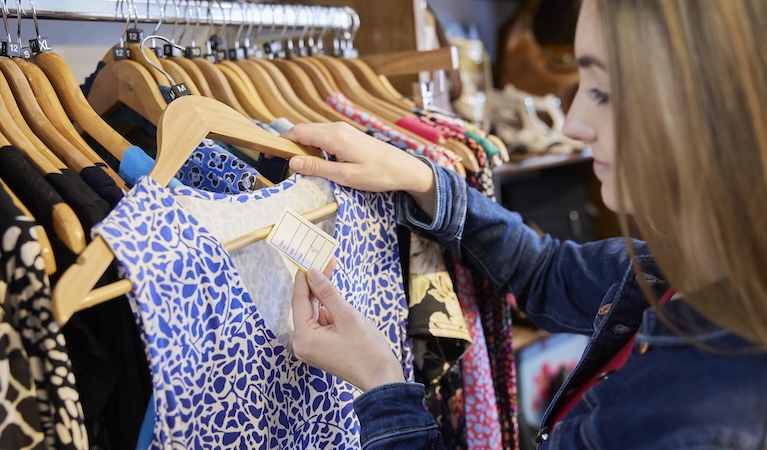You may have noticed recently the Oxfam initiative Second Hand September. This is an annual campaign to encourage people to pledge to say no to buying new clothes for 30 days.
But what is the point of Second Hand September? And is it possible to apply the principles beyond just one month?
What is Second Hand September?
Oxfam’s stated aim of Second Hand September is “Shop second hand to take a stance against fast fashion and dress for a fairer world.”
Fashion has become one of the most polluting industries on the planet in terms of the production and transportation of clothes, as well as a throwaway culture that means millions of clothes end up in landfill every year. 100 billion garments are produced each year, and 92 million tonnes end up in landfill. This is the equivalent of a rubbish truck full of clothes ending up on landfill sites every single second.
This is having a huge impact on climate change. If nothing changes, the fashion industry’s global emissions are likely to double by 2030. And precious resources like water are being wasted every day.
So the aim of Second Hand September is to recirculate existing clothing to help to reduce the demand for fast fashion, and in turn reduce the damage to our planet.
The advantages of buying second hand clothing
The good news is that there are many personal advantages to buying second hand clothing as well as contributing to the good of the planet. Three of these are:
- Buying second hand is a great way to save money. If you look carefully, you should be able to find the brands you know and love at a fraction of the original price. Reinventing your wardrobe at normal prices would probably require a personal loan, but if you buy second hand you can add various items to your wardrobe without spending a small fortune;
- Buying second hand enables you to build up a wardrobe that is unique to you. Many second hand items are no longer available en masse, so it is unlikely you will see anyone else wearing them. Which means no more “same dress” incidents on a night out!
- Many second hand items are excellent quality and will last for years. This applies particularly to vintage items that were produced before the days of fast fashion, and may even be partly hand made.
Preparing to buy second hand clothing
Once you discover second hand clothing, you will be hooked! But it’s still important to buy only what you need, and will use, rather than being enticed by a bargain that may not actually work for you.
So the best place to start your second hand clothing shopping is in your own wardrobe. Go through everything you have and separate out anything that you no longer wear. Even if it is something you like, unless you are actively using it, there is no point in it taking up precious space.
Any clothes you are getting rid of can themselves be recycled, and we’ll look at ways to do that later.
The important thing at this stage is to become familiar with everything that is in your wardrobe, which items work with which other items, and where are the gaps you need to fill. Make a wish list of the items that you are actively looking for. Then you will be ready to start shopping to fill those gaps.
One potential disadvantage of second hand shopping is that you may not be able to find what you are looking for straightaway. So it’s important to be patient and take time to fulfil your wishlist.
One tip from experienced second hand shoppers is that it helps to plan at least one season ahead. For example, you are more likely to be able to grab a winter coat bargain in spring than in autumn. In fact, you may find prices online and in charity shops are slashed even further for off-season items to clear space for new stock.
In the meantime, you will save money if you unsubscribe from any mailing lists from fashion retailers that entice you to buy new clothing. Use the time you’d spend reading those emails to look more widely for second hand items instead.
Where to buy, sell and donate second hand clothing
Of course, as well as buying second hand clothing, you will be contributing even more to the second hand economy if you begin to recycle your own clothing. There are many places you can either donate or sell clothes as well as buying them. Here are five ideas that may help:
- Charity shops. Get to know your local charity shops : what kind of stock do they seem to prefer and what demographic of customer do they attract. You can then work out which ones you prefer to buy from and which are the most likely to benefit from you donating your stuff. Some charity shops also have online selling sites, such as Oxfam Online Shop.
- Local online selling sites. Sites such as Facebook Marketplace and many other local spin-off sites are great places to sell second hand items. And the more local the better, because you could end up selling items, with cash in hand, the same day that you list them.
- Online auction sites. The best known online auction site is eBay, but there are several other sites also dealing in second hand clothing, such as Vinted and DePop. If you like particular brands, also look out for social media groups that may exist to resell those brands.
- Free sites. If you prefer to give items away and want to do it online, there are many ways to do this. One specific site is Freecycle, but also check out your local Freebay site on Facebook, and local online classified ads.
- Car boot sales. Car boot sales can be a good place to sell used clothing as long as you display your items well so that they don’t just look like a pile of rags. If you are going to sell clothes at a car boot sale we’d recommend a hanging rack to make items easy to see, and also clear labelling with size and price.
Another great option is to organise a clothes swap event. This could be just a casual evening with a few friends, drinks and nibbles, and everyone bringing a few items to pass on. Or you could make it a larger community event, perhaps also charging entrance and using it as a fundraiser for charity. Either way, you could end up with a lovely wardrobe refresh for next to nothing.
We hope that this article has given you some inspiration about how to incorporate second hand clothes shopping into your lifestyle, and that it will help you and your family to save money on your clothing bills.
Do check back here soon for more financial and lifestyle tips from Loans 2 Go.


 Now is the time to start planning your financial goals for 2026
Now is the time to start planning your financial goals for 2026 
















